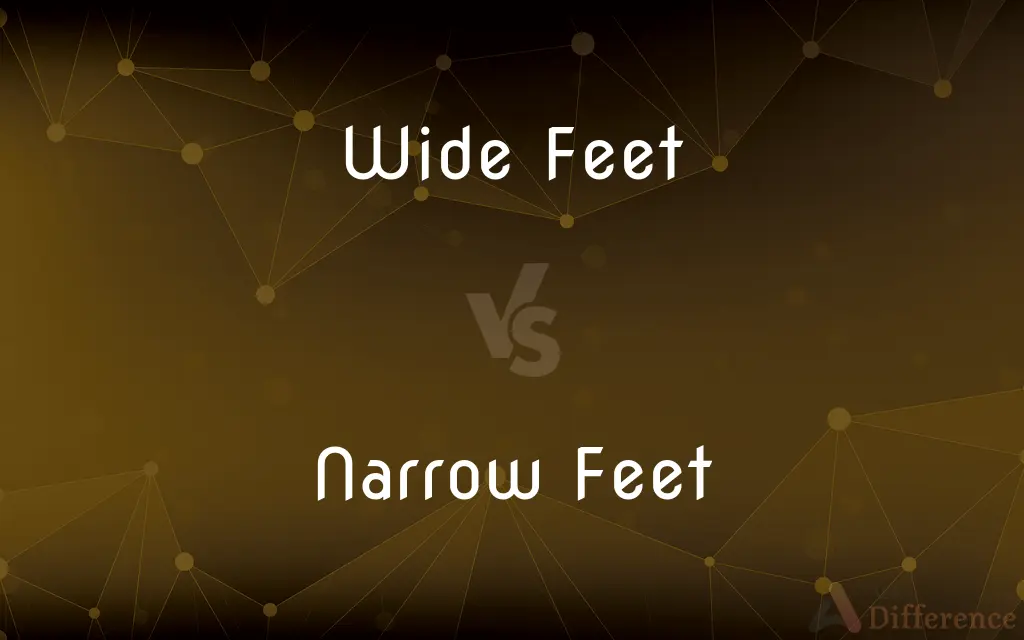Wide Feet vs. Narrow Feet — What's the Difference?
By Tayyaba Rehman — Published on November 21, 2023
Wide Feet are broader across the width, while Narrow Feet are slimmer in comparison; both terms refer to foot shape variations.

Difference Between Wide Feet and Narrow Feet
Table of Contents
ADVERTISEMENT
Key Differences
Wide Feet and Narrow Feet describe variations in the shape and width of individuals' feet. Wide Feet essentially refer to feet that have a broader width compared to the average. This means that the span across the ball of the foot and the arch is more expansive, and individuals with Wide Feet often require shoes that provide extra space in the width.
On the other hand, Narrow Feet are those that are more slender or less broad compared to the average foot width. This means that there's less span across the ball of the foot and arch, resulting in a more streamlined appearance. Individuals with Narrow Feet might often find that regular-width shoes feel too spacious or loose.
Both Wide Feet and Narrow Feet are natural variations in human anatomy. People may have either foot shape due to genetics, developmental factors, or other reasons. Importantly, neither is indicative of health or functionality; it's merely a matter of fit and comfort, especially when choosing footwear.
One's foot width, whether wide or narrow, can influence the type of shoes they buy. For instance, someone with Wide Feet might opt for shoes labeled as "wide" or "extra-wide" for comfort. In contrast, someone with Narrow Feet might look for "narrow" shoe sizes to ensure a snug fit.
Having a clear understanding of whether one has Wide Feet or Narrow Feet can make shoe shopping more straightforward. It can prevent discomfort, blisters, and other foot-related issues that arise from wearing ill-fitting shoes. Ultimately, recognizing and accommodating one's foot shape is vital for foot health and comfort.
ADVERTISEMENT
Comparison Chart
Definition
Broader foot width compared to average
Slimmer foot width compared to average
Appearance
Expansive across the ball and arch
Streamlined across the ball and arch
Common Shoe Label
"Wide" or "Extra-wide"
"Narrow"
Fit Preference
Shoes that offer extra width
Shoes that are more snug in width
Result from Ill-fitting Shoes
May feel constricted in standard shoes
May feel loose in standard shoes
Compare with Definitions
Wide Feet
Wide Feet might feel constricted in standard shoe widths.
He always feels squished in regular shoes because of his Wide Feet.
Narrow Feet
Narrow Feet show a streamlined appearance across the ball and arch.
Her Narrow Feet often make boots look oversized around her ankles.
Wide Feet
Wide Feet require spacious shoes across the width.
Due to her Wide Feet, she prefers buying extra-wide shoes.
Narrow Feet
Narrow Feet have a slimmer width than average.
Ballet flats often fit those with Narrow Feet quite well.
Wide Feet
Wide Feet display a more expansive span across the ball and arch.
Shoe inserts often don't fit those with Wide Feet.
Narrow Feet
Narrow Feet may require shoes labeled as "narrow" for a snug fit.
She always checks for the narrow label due to her Narrow Feet.
Wide Feet
Wide Feet can result from genetics or developmental factors.
Several family members have Wide Feet, so it might be genetic.
Narrow Feet
Narrow Feet might feel that regular shoes are too spacious.
Standard-sized sneakers often feel too roomy for his Narrow Feet.
Wide Feet
Wide Feet have a broader width than average.
My Wide Feet often make it challenging to find comfortable shoes.
Narrow Feet
Narrow Feet can be a result of genetics or developmental reasons.
His sibling also has Narrow Feet; it might run in the family.
Common Curiosities
Can wearing the wrong shoe width cause problems?
Absolutely. Ill-fitting shoes can lead to blisters, discomfort, and other foot issues.
Is it challenging to find shoes for Narrow Feet?
Some people with Narrow Feet might find standard shoes too loose, but many brands offer "narrow" sizes.
Can foot width change over time?
Yes, factors like weight gain, pregnancy, or medical conditions can influence foot width.
Are Wide Feet and Narrow Feet genetic?
Yes, foot shape, including Wide Feet or Narrow Feet, can be influenced by genetics.
Do Wide Feet or Narrow Feet affect athletic performance?
Foot width doesn't inherently affect performance, but wearing the right shoes is crucial for comfort and prevention of injuries.
Is there a way to measure if I have Wide Feet or Narrow Feet?
Many shoe stores offer foot measuring services, or you can measure at home and compare to standard width charts.
Are there exercises to change foot width?
While exercises can strengthen feet, they won't drastically change foot width.
Do people with Narrow Feet have a higher arch?
Not necessarily; foot width and arch height can vary independently.
Are there specific brands catering to Wide Feet?
Yes, many brands offer "wide" or "extra-wide" shoe options for those with Wide Feet.
Can children have Wide Feet or Narrow Feet?
Yes, children can also have variations in foot width, and it's essential to get them properly fitting shoes as they grow.
How do I care for my feet, whether wide or narrow?
Regular foot care, wearing the right shoe size, and periodic foot assessments are essential for foot health.
Can foot width influence balance?
While foot width might slightly affect balance, overall foot health and strength play a more significant role.
Are there specific materials better for Wide Feet?
Shoes with stretchable material or adjustable straps can offer better comfort for Wide Feet.
Are there insoles for Wide Feet or Narrow Feet?
Yes, there are specialized insoles designed for different foot widths to enhance shoe fit.
Are there any health issues associated with Wide Feet or Narrow Feet?
Neither inherently indicates a health issue, but ill-fitting shoes can lead to foot problems.
Share Your Discovery

Previous Comparison
Remit vs. Submit
Next Comparison
M.B.A. vs. P.G.P.M.Author Spotlight
Written by
Tayyaba RehmanTayyaba Rehman is a distinguished writer, currently serving as a primary contributor to askdifference.com. As a researcher in semantics and etymology, Tayyaba's passion for the complexity of languages and their distinctions has found a perfect home on the platform. Tayyaba delves into the intricacies of language, distinguishing between commonly confused words and phrases, thereby providing clarity for readers worldwide.













































